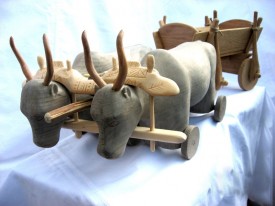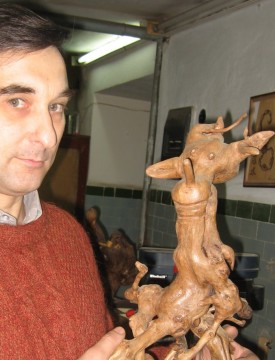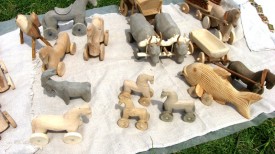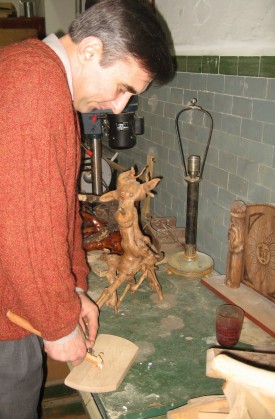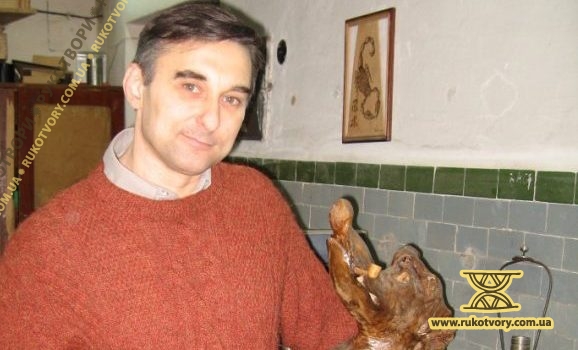
We met with the famous national toy maker Anatoly Brovchenko in the hall of the National Pedagogical University named after M. P. Dragomanov. Entered the basement of the university building where he usually trains students. Wood boards and different devices for wood trimming set by the walls immediately caught my eye. Mister Brovchenko teaches technical art, decorative design and woodworking technology.
Later we entered one of the rooms. I saw about a dozen of students’ works in the dark corner of a cabinet. Among them a composition with two wooden cranes near a lake made of glass was especially notable.
— This one (the composition with the cranes – auth.) the students were making under my, I’d say, thorough guidance – explains the artist – because young people nowadays are into making money and not many of them want to work with wood.
In what style do you usually work? — I ask the artist.
I like ancient forms, ancient design, ancient spirit and colours… And carved wood in those ancient colours with which I work I would call the grey wood style. I like grey tints – the ones we can see in the nature. When wood is left in the open air for long it starts to grey because of the oxidation process. That is why the white carved wood is often artificially aged and it becomes greyish.
Works in this style may not be very prominent from the decoration point of view but if they are rich with contents they look beautiful enough. Anyway, it’s difficult for me to speak about my own works. Let people speak about them. Some like them and some not. I visit different fairs, so occasionally some person can come up to me and say depreciatingly: “Ah, it is primitive work, let’s go with me and I’ll show you I can do the same”… But there always are some people who are interested in what I do and how I do it, so I communicate with people and pass something good to them… We try to work from the heart and do our best.
In what ways toys are attractive to you as an artist?
They attract me by their simplicity and monumental unity. Everything is exact, clear and simple. If it is a tail one has to make two furrows of some kind (a kind of a long slit in something; a wrinkle or a fold – auth.), and it gets clear to any child or grown-up that it’s a tail, so everyone perceives it as an animal form. But when anything is made too arrogantly precise – for example a horse is modeled with separate hairs falling down from the mane or with eyelashes, eyebrows or a nose – then it will look like a real horse but one can simply go the field to take a look at such a horse. What is really difficult – is to obtain with two or three incisions an animal figure which will be symbolic and at the same time could be recognized as an animal you wanted to imitate. That is why the skill must lie in the ability to achieve maximum simplicity and to reflect your initially intended emotions.
When did you start to make toys?
In general I’ve been working with wood starting from the fourth grade of my school. As for the area of the carving, I started to master it 8 years ago, because previously I had practiced only root shaping – making candlesticks, mirrors, tables, chairs, shelves, panel pictures… Later gradually I switched to the wooden gouged dishes and then to the toys and now it’s my job. Some time ago Oleksiy Dolya from Pirogov museum encouraged me in this. I once showed him a work of mine and he said: «They are real toys. You go make them because we are soon having an exhibition». I showed my toys at the exhibition and everyone liked them… I started to make them and somehow became keen on it by and by. There is one more thing that attracts me in the toy. It is that the expenses are not high – neither in material nor in physical strength: you see the toy at once and can implement a lot of different ideas…
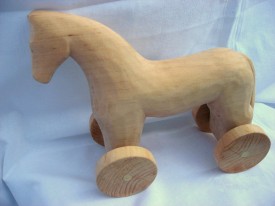 Can you list the names of the toys you carve?
Can you list the names of the toys you carve?
They are moving toys – horse trolleys, oxen with carts. Not long ago I started to make landrails from apple-tree boughs because they are twisted and have a specific look. There is an artist who’s been making landrails long, so in order not to interfere with his work (because our artists do not like it when somebody starts to make similar products) I make quite a different kind of landrails. At present I also want to make ornamented toys in forms of violins… Beside that I invent all sorts of carts with horses from single pieces of wood. They can be of different shapes but of the same nature: it’s usually a horse and some kind of a vehicle (a sledge or a cart). Somehow I feel attracted to the hoofed animals (laughs). Not long ago I started to make toys in the shapes of birds. They are birds with spread wings; they can be hung somewhere on the chandelier or under it. When someone touches the bird it swings and seems to be flying. This toy is an ancient one. Once it symbolized the divine spirit. Birds inspire me by their simplicity and some kind of sweeping force. It’s that they are made simply from two pieces of wood but possess something indescribably magic that is impossible for me to explain.
So, to say that I make just a definite range of toys will not be correct. I try to make everything I like. For example, I tell you this and that today, but tomorrow I see something different, invent something else and will make it. The main things here are the idea and the wish. When an artist has finished a piece of work it takes him two days to see enough of this work and then the thing gets uninteresting to him and he wants to make something new. It is similar with other people: a person looks at a thing, buys it, hangs it up and looks at it for some time – I don’t know whether it is two days or more – but later this person wants to buy something again. So, it’s a kind of a ring connection: and artist makes a thing, looks at it, sells it, someone buys it and later gives it as a present to someone else.
The creator of toys continues the excursion around the studio. We come up to the stand stuffed with different kinds of wood and roots.
— I keep here raw parts from different unusual roots. It is possible to make a lot of beautiful things from them. Sometimes I happen to have customers who want something of this kind. Then I can do anything from these parts: a lamp or a shelf, or some kind of bonsai (miniature plant in a flat flowerpot – auth.).
These roots – of what tree are they? – I point at a twisted form which will clearly be turned into a stylish modern shelf some day.
It’s a linden. I saw a very old rotten linden close to a road once, so I tore out its roots.
And this one is what I found walking in the forest (the artist pulls out another root with long shoots from under some things lying on the shelf). Someone trained dogs with it but it’s practically a ready ostrich. You see: these are two legs, a tail, and it takes only to finish the head. The cost is minimal. It needs only a day of work to make it a “super” thing. It can even be sold…
And here we have a lisovychok – a wood goblin – from vine. Someone must have cut a vine and threw it out. And we’ve made this wood goblin from it. These are old works.
That is – one can make something beautiful practically from anything?
From everything! Even from rusty iron, wire or cans it is possible to make something. The only thing needed is a bit of a brain work.
From what kind of wood do you usually make items for fairs?
Linden, poplar, willow and anything close at hand. I can’t be very choosy because there’s little to choose from.
You don’t cut trees intentionally?
Oh, no. You can always find dry snags and brushwood in the forest. We don’t need to cut green trees because they are alive. Such wood needs drying and is too heavy to carry without transport. Nowadays it is possible to buy wood as well, the price is rather reasonable.
Mister Brovchenko reaches out to the upper shelf and takes into his hands one more of his works.
— My friend and I used to make supports for flowerpots. Such things are called slabs (An outside piece cut from a log when squaring it lengthwise for lumber– auth.), and usually they are thrown out when the log is cut for planks. So we took one to make a support for a flowerpot. It is hard, static and will serve long. One has only to set it and one gets a piece for feng shui (laughs).
We even used to make bows. They appear to be not so simple. They are very expensive at the market nowadays. I made this one for my son (shows me a long bow from white wood). One has to know the wood properties otherwise there will be no success. Certainly, you can cut out a stick and bend it up to your knee, but it will not be a worthy thing. I used to make bows with which it was possible to go hunting – they had the same killing power as real weapon.
The main thing is to timely prepare wood and to dry it in a correct way so it doesn’t crack. Or it is possible to use only cutting. For example, large woodworking shops usually dispose of such cutting so I take it there and make horses from it.
Wood is practically as expensive as gold if to financially count everything. Amazing that it is simply burned. One acquaintance of mine has a workshop in Borshchagivka (a region in Kiev) and there are stores of such cutting in his worksop. He says it’s for firewood. Good dry wood with maybe a twig here or there easy to cut off, but they burn all of it. If to open a workshop upon that it would be possible to heap up the entire Troeshchina (another region in Kiev) with wooden toys! But no one does it because there is no profit in this: either the authorities suppress it in a way or people don’t want to do it.
Only a few people are occupied in this. An acquaintance of mine has opened a workshop of such kind but the toys need to be certified for ecological purity, so this person says it requires up to one thousand dollars and a half to certify just one toy. And he says it was easier for him to certify the toys in Baltic republics and Baltic people buy them with pleasure. And it’s not possible here in any way. It is profitable to make toys in the entire world except Ukraine.
Why is it not profitable?
Any product needs popularizing. And a definite quantity of the products is necessary to do this. Some statistics is also required to explain why they are not manufactured (meaning the extensive manufacture of wooden toys – auth.). The fact is that there is no manufacture but there are all the conditions for that – availability of materials, artists, tools.
A lot was said about this at the exhibitions in the Taras Shevchenko museum. They were held each year and everyone came to them – government officials, journalists and TV people. All of them were at a loss. They said the following things: it is all very good, we have everything we need for this in our home country, it’s much better than a “Barby” doll, it’s ecologically pure, it’s popularization of the national ideas, the children will not grow like “batmen” and wicked and so on… Well, after the talk the government officials said: “It needs to be done” and everything stopped at that point.
I don’t know what needs to be done. I am just a small person, an artist. I can work and if I am supported I can do much more.
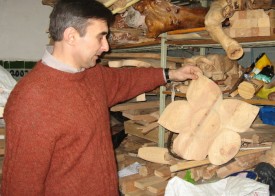 You spoke about the product certification… Is it needed at the festivals as well?
You spoke about the product certification… Is it needed at the festivals as well?
It’s the same as with the hog’s lard at the market. It is examined and if it is not contaminated then it’s edible. I once made and sold a spoon and didn’t need a certification for that. All the more – no one will chew it. Though moms do buy their children small horses called «grezuntsy», meaning something to gnaw at, so that the children could gnaw at those horses when they are teething. It is really better than to gnaw at plastic. I don’t go into this deeply and I don’t know what principles and what certificates exist. We are given the right to sell things at the fairs – so we sell them, if we are prohibited from that – we will not sell anything.
Has the number of people willing to buy hand-made things increased after years or quite the contrary? What is the tendency?
The number increases every year. Maybe earlier people lived poorer and nowadays they are wealthier and have started to go abroad more often, they need presents… I once imagined myself in their shoes. Let’s say my friend lives somewhere in Czech Republic. What can I bring to him if he has everything? If you drop in somewhere to buy a souvenir you’ll find only matryoshkas, those silly wreaths and oberegs (hand-made things intended to guard houses or homes as charms), that is all. What if a person wants to bring something that is national, functional and at the same time handy and nice? That is the reason why people go to fairs and choose from the works shown there. Even wholesalers come and buy products in such numbers that the manufacturers practically have nothing left after that.
And the price grows… But usually it is not the poorest people who buy toys and they can buy rather expensive toys. If to speak about oxen (I don’t do many of them because the costs are high) they can cost a thousand or even several thousand UAH. As for the average price of a horse (depending on the complexity of work) it is about a hundred UAH.
I don’t make my living on this. So I don’t go around thinking where to sell all my works to earn my bread. I have a job and make things from wood when I have some free time, even at home sitting in front of the TV in the evening. If I’ve made something I sell it. So it’s pleasing for a person who buys the thing; and from my side I get additional money to maybe buy something as they say “fancy” for my son; and I meet and communicate with people in the process. Because all the artists when they come to fairs feel as a kind of brotherhood or relatives… That is why the artists who know each other take places side by side at the fairs and feel like neighbours. You always have someone to talk to or to look over your works while you are away. A lot of artists nowadays come to fairs with the aim to communicate.
I think such fairs have future and the artists will continue to work. Whether this will become popular everywhere and will be aimed at creation of a genuine Ukrainian souvenir depends upon the government and not upon us.
How do you find life for artists in Ukraine nowadays?
A lot of attempts have been made to give some privileges to artists but in Ukraine there is an official Union of National Artists and when any law is accepted it is oriented at this Union. But only a limited number of people are accepted to this Union and I will not speak now about a principle on which it is done. Maybe it is right. But the Union has set fourth some definite principles for determining who is a national artist and who is not. Though from the other hand, what does the term “national” mean? Am I not national and they in the Union are? But for those who are recognized as national artists there are some privileges during payment for gas and some addition to pensions. And those artists who do not know how to apply for membership in the Union or do not want to enter it happen to be a kind of discriminated. That is why it is needed to introduce an approach that will satisfy everyone…
What is the first spring fair to which you bring your works to show?
It is the first week-end in May, in Pirogov museum. This fair is the first one for the artists to show their works after the winter. It is the richest one. By the way, if you want to buy something then this fair is the best for it, because later by the summer the best works will already be bought. And then during the summer we have a lot of smaller so called “subfairs”…
At present I keep majority of my works at home. I’ve piled and hidden them at home and I am waiting now (laughing) because it’s a long time until the next fair…
A lot of artists go to Sorochynsky fair because it is well advertised. I’ve been there twice or thrice… When I first went there I didn’t find the organization good enough but it was acceptable. By my second visit the organizers had covered 20 meters of road with asphalt there and asked us to pay money for that to repay the costs. They started to measure the ground by square decimeters and artists had to pay much money. I was measured all around by a tape-line and said: you shouldn’t put your bag at this place. But I paid a lot of money for the participation in the fair that time… To say nothing about spending a night… I go the Crimea to sea and to stop overnight in Crimea costs less. I said I would not go there any more though now I get invitations… It’s an ill fair and it’s a disgrace for Ukraine if Sorochyntsy is called the main Ukrainian national fair…
Where in general do you go?
Oleg Skrypka organizes a very good festival called “Dream country”. The organization is of high quality, and the festival itself is super. I wish we had three of this kind instead of one, though now in Ukraine in general there are hundreds of them. People go around the fair and invite the artists: “Come to us to Kamyanets-Podylsk, come to us to Lutsk, come to us to Odessa”… Well, they say “come” but I can’t fly, you know. Only my bag with wood is so heavy it is difficult to lift. I say to such people if they can come and take me to the place and back I can participate. But they want it cheap but good. To give an artist ten gryvnas and a sausage when he’s come and say goodbye. But if I go somewhere I should have some profit and want to spend a night in normal conditions.
Have you visited Sheshory?
I haven’t been to Sheshory. I was invited once and very politely, too, but I refused. Later I didn’t get any invitations and didn’t have time because I am busy at work and I cannot leave it. However each summer I have two months of vacation. It’s a kind of free time when I can travel. A friend of mine, Ponomarenko-Teslenko (a national artist Ludmila Ponomarenko-Teslenko known by her motankas (hand-made dolls, twisted and bound from cloth, threads or straw without sewing or cutting) – auth.) visited Sheshory and judging by the photographs it could be said that one can have a good time there.
But if a person sets a task to make a living at these festivals making and selling things to raise the children then I should say not all of them are suitable for this and meet certain criteria. You sure can take 5 works, throw them into a bag, go to a festival, have a drink and participate in dancing – that is great and I like such things, but it is a bit different field. And if when coming there you take two heavy bags with your works which can pull your arms off, you have to buy a car. And to buy a car you horses need to be even more expensive (laughs). Then you get a closed circle. It is good that I live in Kiev…
Do you get individual orders?
This year I get fewer of them. But in general I have enough so that I even turn down some of them. Earlier I used to advertize myself. Later I started to take only interesting or expensive orders. It is not interesting to make small things because it is difficult to guess what exactly a person has imagined. So I say to people I am not a foreteller Vanga for me to understand what they think. For example, I have finished something and the client says: “you know I would still like an opening here and a rounding there, and it would be better if to change the colour from yellow to brown, then surely I… Can you change it this way?” So when I’ve made a certain number of works from hart and exhibit them people come and say they like this and that. People buy what they like and everyone is pleased – the buyer and the seller. And when making a small order you keep thinking about whether you do it the way the person is expecting from you. So I don’t like this kind of work much. But if the order is worthwhile then I make a draft first and show to the client. We agree upon it, specify the colour at a wood sample. Sometimes I get orders from different funds and sometimes from people because nowadays it is considered fashionable to have country houses – dachas as we call them.
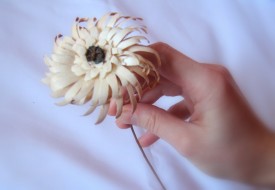 What was the strangest order you remember?
What was the strangest order you remember?
I have an acquaintance who collects thimbles and says: “Your works are so fine, so can you make me a thimble in the shape of a chair the same way you make buckets from a single piece of wood? Such kind of s thimble.” I scratched my head and thought – well I will do it, but what exactly to make? Because I don’t see it the way she sees. Then I ask her: “Will you explain your vision to me somehow?” and she replies “I will take it as is when it’s reade”. Well, I’ve made the thimble and everyone says “It’s a bucket!” “No, it’s a thimble” I reply and get “You don’t say so” as a response. But my acquaintance liked it. Though I had previously thought that if she wouldn’t have I’d turn it upside down and sell it as a bucket (laughs).
To show me his handicraft Mister Brovchenko cut a flower from wood before my eyes literally in five minutes and gave it to me as a souvenir.
Kateryna Kachur
